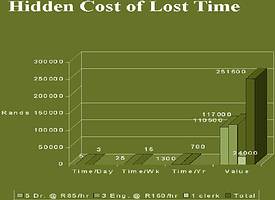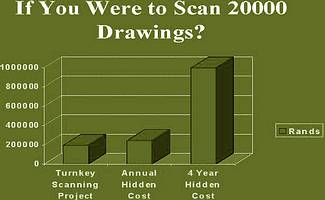Why scanning? - a South African perspective
October 2002
Information from Image Scanning Technology
International research has shown that of all the technical documents in existence at this time, some 60% of the documents are still in paper/film form. The balance is made up of aperture cards (25%) and CAD (15%).
This makes sense, as the computer and CAD software has not been around as long as the drawing board. What is even more surprising is that the research shows that of all the new technical documents being produced some 50% are still being generated on the drawing board and the balance on computer. This bodes well for the large-format scanning bureau and for the manufacturers of large format scanning equipment. But does this apply to the South African market?

Example of hidden costs related to wasted time and expanded over a four-year period
South Africans had (and in some cases still have) a reputation of being 10 years behind the rest of the world and as far as converting paper into a digital format is concerned, this is still definitely the case. The history of the large-format scanning industry in South Africa shows a definite trend that organisations have a 'more is nog 'n dag' mentality. This means that a lot of people have an attitude of 'we have had these drawings for the past 50 years so what difference will a few more years make' or 'yes, we want to scan all our drawings, but we want to do it ourselves'.

In the latter case, history has shown that a very large percentage of all the large format scanners sold into the South African market place have been grossly under-utilised and in some cases not used at all. What is worse is that a large percentage of the organisations that have invested in large format scanners have still not scanned in their drawing archive. A large number of those organisations that have succeeded in scanning in their drawing backlog are now sitting with very expensive pieces of equipment that are standing idle and collecting dust.
The economy of the country over the past 10 years or so has also not helped the large-format scanning market at all and some organisations genuinely do not have the financial resources to have their drawings scanned into a digital format. Other organisations have financial managers channelling funds into other resources, such as IT resources, leaving the drawing office manager to cope with out of date filing/indexing systems. Another influencing factor is the fly-by-night operator who tackles a project that he is not geared up to do, makes a hash of the job, leaving the client to believe that scanning does not work.
Quality is an absolute necessity in maintaining the integrity of the documents, and one should guard against operators who are more interested in finishing a job and scoring a quick buck, rather than in providing the client with a good quality image.
So what are the benefits of going digital
* Security against catastrophic loss. The loss of drawings through fire, water or just negligence can cost a company a great deal of money. It is difficult to place a value to a drawing as each and every drawing represents something different. Is the value associated to the cost of the draughtsman's time to produce the drawing or is it associated to the value of the piece of equipment or structure that it represents? Each and every company places its own value to its drawings.
* Ease of access to the drawings.
Once drawings have been scanned and archived in a digital format they will be accessible to a user with only a few keystrokes. The current hidden cost associated with lost time looking for the correct drawings will be done away with. Slide 1 shows an average-sized drawing office with three engineers and five draughtsmen. We know that in reality a lot of time is wasted by people looking for drawings in a filing system where the drawings have been misplaced, not returned, etc. Let us assume that the engineers cost R150 per hour and the draughtsmen cost R85 per hour. If each person wastes an hour each day trying to locate a drawing, a document or some other information, then over a year they have effectively cost the company R25 1500 doing something other than what they were paid to do. If the data were available in digital format, ie, on CD, server, or some other digital storage system then the data would be available at the click of a button, thereby saving an enormous amount of time and money. If you were to expand this hidden cost over a four-year period, wasted time would have cost the company R1 million.
* No lost drawings or data. With the data in digital format with the correct back-up system in place there would be no lost drawings or data.
* Hybrid editing saves on re-drawing time. Most modifications to drawings require only a portion of the drawing to be modified. The trend in the industry is to totally redraw the drawing, which takes a lot of time. If the drawing were to be scanned and in a digital format and you had raster to vector conversion software then one only needs to modify the portion that needs to be changed not the whole drawing. A person can then create a hybrid file, a combination of raster data and vector data. This can easily be plotted out and given to the site foreman or whoever else needs the modified drawing.
One thing to bear in mind is that a turnkey scanning project is a once off cost. The hidden costs go on year after year.
For more information contact Image Scanning Technology, 011 484 3442.
Others who read this also read these articles
EDM - who needs it?
An EDMS is basically a computer database system designed for keeping track of documents, changes to them, related documents, and possibly to control the access to documents and assist or even enforce established procedures for workflow or QA[ December 2005 ]
Spatial document management
ProjectWise is the most popular technical document and AEC content management tool in SA and adding a spatial component opens up a whole new dimension[ August 2004 ]
What is up, docs?
DvTDM, the Total Document Manager developed by Practical Programs, and is available from Kinetic Distribution, can actually be configured to force documents to be stored within the system[ August 2004 ]
The CAD File is the business
CAD files form the technical foundation from which industrial businesses and plants are run[ August 2003 ]
The high cost of information erosion
Intergraph Process, Power & Offshore has developed integrated solutions and products to assure data accuracy and consistency, and enable the efficient creation, management and use of plant engineering information throughout the plant lifecycle[ June 2003 ]
Powerful document management solution
DataViewer X is an advanced Document and Drawing Management solution that can interface with leading CAD products to produce advanced technical and product document solutions[ February 2003 ]
Digital signatures resolve electronic catch-22
The much-touted 'paperless' work environment has finally become a reality[ December 2002 ]
MicroStation V8 is e-ready for digital signatures
Recent acknowledgment of digital IDs, certificates, and signatures offers new opportunities to streamline workflows and strengthen the protection of one's digital intellectual property[ October 2002 ]
Others who read this also read these news items
A solution to CAD data management problems
[ October 2005 ]
Engineer your drawing management
[ August 2005 ]
The paperless age
[ June 2005 ]
Effectively handle document processes
[ April 2004 ]
Flexible solution for digitising drawings
[ February 2004 ]
Dataviewer X gets new name and enhancements
[ February 2004 ]
World's largest export coal terminal discovers SAP DMS
[ February 2004 ]
New software to index and archive scanned drawings
[ February 2004 ]
Others who read this also read these regulars
Search Site
Subscribe
Previous Issues
Other Technews Publications
Other Technews Buyers Guides
 |  | Copyright c1995-2009 Technews Publishing (Pty) Ltd.. All rights reserved. |